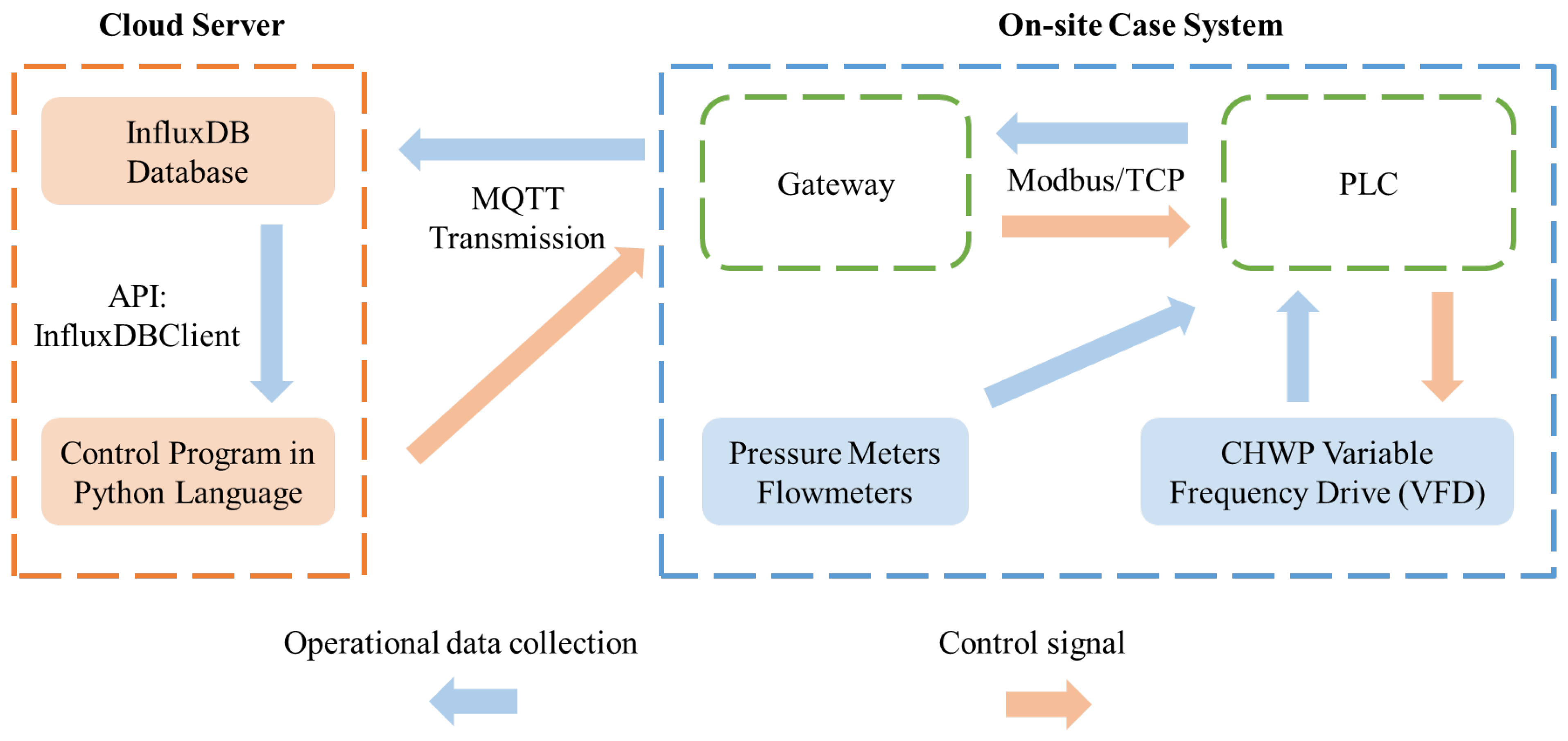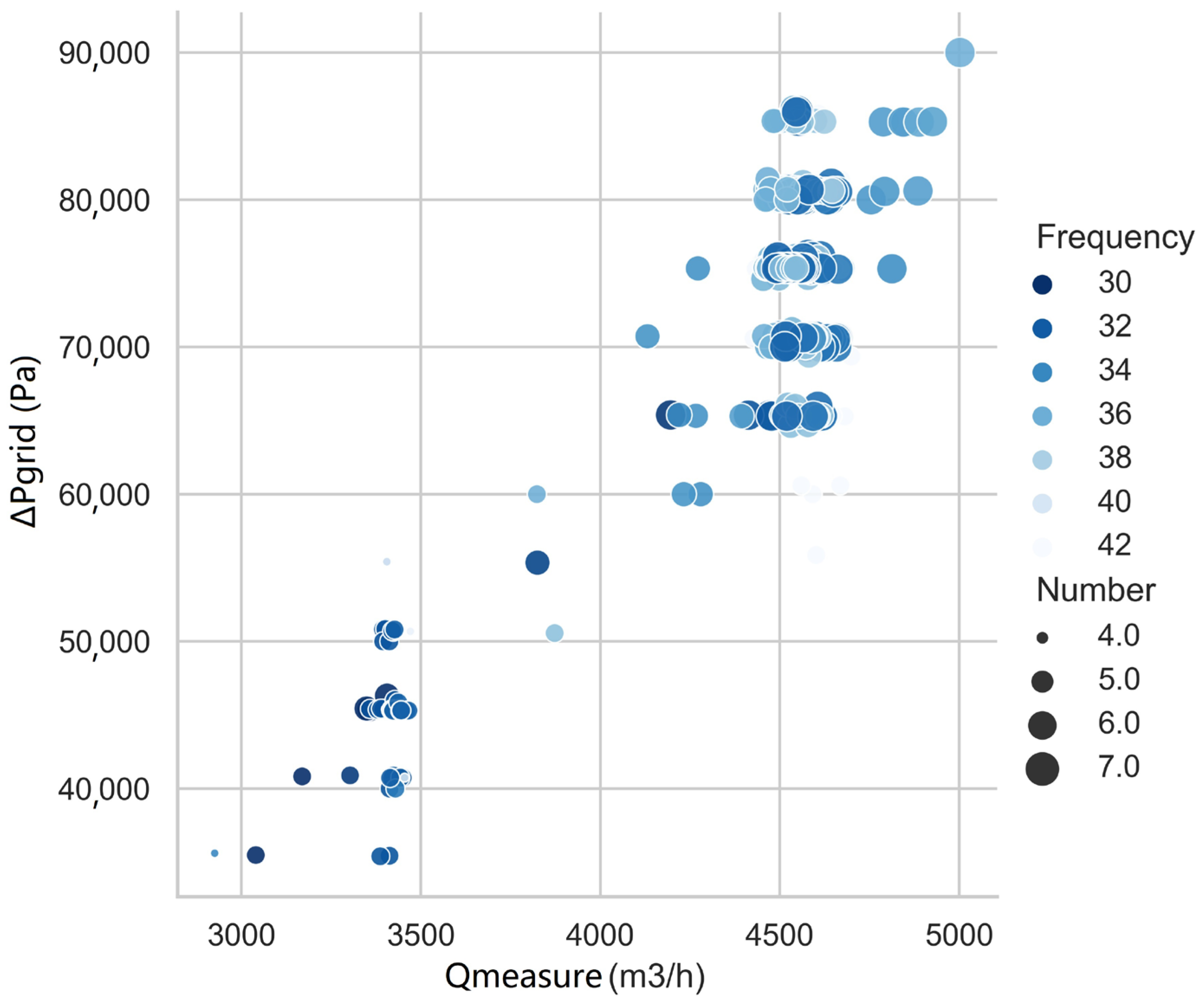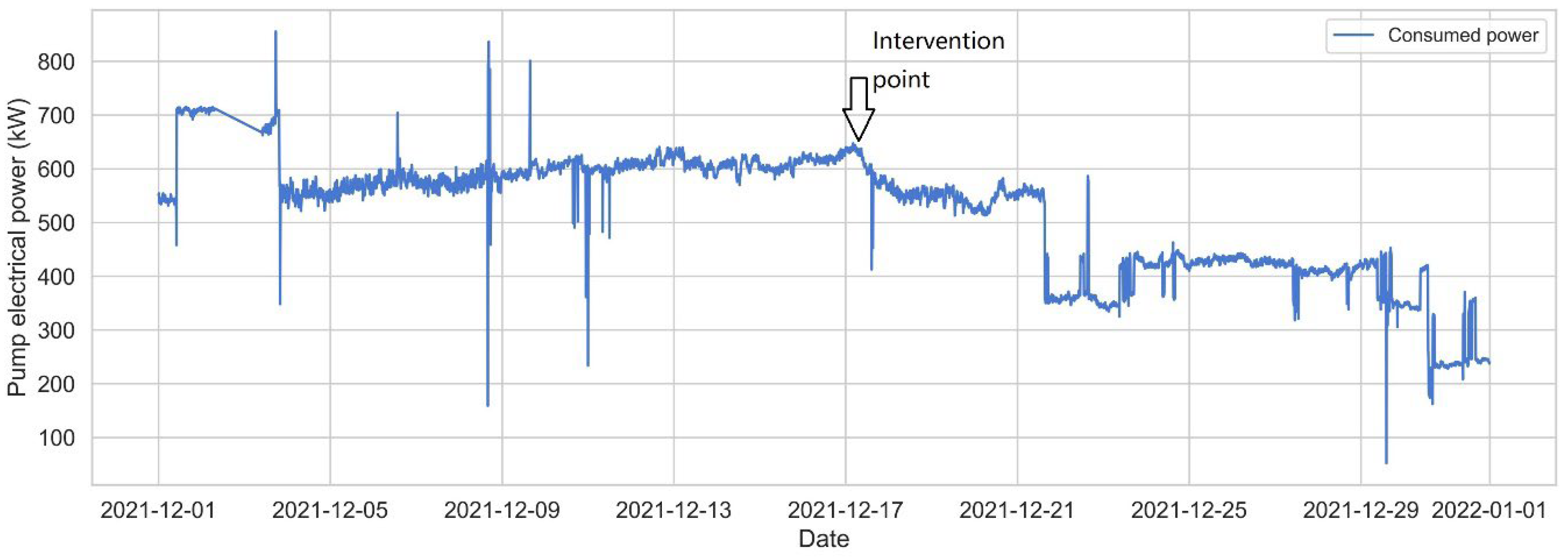Active Optimization of Chilled Water Pump Running Number: Engineering Practice Validation
Abstract
:1. Introduction
1.1. Background
1.2. Literature Review
1.3. Targeted Problem and Research Motivation
2. Methodology
2.1. Overview
- (1)
- Offline preparation: The optimization process of the proposed approach is based on pump performance curves and similarity/affinity law, so the performance curves of the targeted pumps should be available before the application of the proposed method. Specifically, nominal/reference pump head curve (i.e., pump flow rate versus pump head) and nominal/reference pump power curve (i.e., pump flow rate versus pump input electrical power) are needed (they are usually provided in the equipment manual). Both curves are assumed to be accurate by default. In addition, the safe range of pump operating frequency is required, which is usually available in pump manuals.
- (2)
- Compatible system type: This method is compatible with the differential pressure-based chilled water system, in which pump speed/frequency is controlled to maintain the pressure difference between chilled water header pipes at the set point [8]. If the targeted system is based on differential temperature to control pump speed/frequency (not so common) [13], then the proposed method cannot be applied without modification.
- (3)
- Requirements on the real-time monitoring/measurement: The proposed method requires real-time data of header pipe chilled water flow rate, grid differential pressure, and the set point of grid differential pressure. These variables are typically monitored by default in real systems.
2.2. Calculation Process
3. Engineering Practice Case Study
4. Results and Discussion
4.1. Short-Term Performance
- (1)
- By comparing the estimated values and the corresponding measured values (after control intervention), it could be seen that the flow rate estimation error is less than 2%, and the frequency estimation error is less than 1 Hz. Hence, the estimation accuracy of the proposed methodology (based on similarity/affinity and pump head curves) is acceptable for optimal control.
- (2)
- About 20% of the pump energy is saved with the proposed method (601–476 kW), which validates the energy-saving performance. The energy reduction is not as significant as results in existing pump frequency control studies (over 30%) [9,11]. But since the targeted control signals are different (running number/operating frequency), it would be not proper to simply compare the energy-saving amount between this study and the other two. Moreover, our proposed methodology is simpler than those in [9,11], which suggests its better feasibility in engineering practices.
- (3)
- Compared to the working condition before the intervention, grid pressure difference changed by 1.4% and flow rate changed by 2.6%, which shows that the water grid operation condition is maintained well; cooling supply is not sacrificed for energy conservation by the control intervention. Moreover, the stable operation of the whole chilled water system means the proposed method would not affect the efficiency of other relevant appliances. Compared to [8,9,11], whose approaches involve the adjustment of the grid flow rate and differential pressure, the method of this study may be more suitable for industrial constructions which requires higher operating stability.
4.2. Long-Term Performance
5. Conclusions and Future Work
5.1. Conclusions
- (1)
- the proposed method is deployed in the cloud server of the cooperating energy management platform (Figure 4);
- (2)
- by default, energy management platforms always need to build data collection-transmission frameworks on client buildings for energy monitoring and management;
- (3)
- real-time monitored variables required by the proposed method are also important and accessible for conventional pressure-based pump control and energy management platforms.
5.2. Future Works
Author Contributions
Funding
Institutional Review Board Statement
Informed Consent Statement
Conflicts of Interest
Appendix A
References
- Li, W.; Xu, P.; Lu, X.; Wang, H.; Pang, Z. Electricity demand response in China: Status, feasible market schemes and pilots. Energy 2016, 114, 981–994. [Google Scholar] [CrossRef]
- Pérez-Lombard, L.; Ortiz, J.; Pout, C. A review on buildings energy consumption information. Energy Build. 2008, 40, 394–398. [Google Scholar] [CrossRef]
- Gao, D.C.; Wang, S.; Shan, K.; Yan, C. A system-level fault detection and diagnosis method for low delta-T syndrome in the complex HVAC systems. Appl. Energy 2016, 164, 1028–1038. [Google Scholar] [CrossRef]
- Lam, S.K.H.; Tham, C.; Saseedharan, S.; Chun, L.Y.; Wang, A. Distributed Pumping Chilled Water Hydronic System for Air-conditioning Systems. Energy Procedia 2017, 143, 88–93. [Google Scholar] [CrossRef]
- Dai, M.; Lu, X.; Xu, P. Causes of low delta-T syndrome for chilled water systems in buildings. J. Build. Eng. 2021, 33, 101499. [Google Scholar] [CrossRef]
- Liu, X.; Liu, J.; Lu, Z.; Xing, K.; Mai, Y. Diversity of energy-saving control strategy for a parallel chilled water pump based on variable differential pressure control in an air-conditioning system. Energy 2015, 88, 718–733. [Google Scholar] [CrossRef]
- Zhu, W.; Jiang, Y. Energy Conservation Using Variable-speed Chilled Water Pumps for Single-loop Chilled Water Systems with Fan-coil Units. Energy Eng. 2003, 100, 22–36. [Google Scholar] [CrossRef]
- Gao, D.-C.; Wang, S.; Sun, Y. A fault-tolerant and energy efficient control strategy for primary–secondary chilled water systems in buildings. Energy Build. 2011, 43, 3646–3656. [Google Scholar] [CrossRef]
- Ma, X.; Gao, D.-c.; Liang, D. Improved Control Strategy of Variable Speed Pumps in Complex Chilled Water Systems Involving Plate Heat Exchangers. Procedia Eng. 2017, 205, 2800–2806. [Google Scholar] [CrossRef]
- Shi, W.; Wang, J.; Lyu, Y.; Jin, X.; Du, Z. Optimal control of chilled water systems based on collaboration of the equipment’s near-optimal performance maps. Sustain. Energy Technol. Assess. 2021, 46, 101236. [Google Scholar] [CrossRef]
- Gao, D.-C.; Wang, S.; Shan, K. In-situ implementation and evaluation of an online robust pump speed control strategy for avoiding low delta-T syndrome in complex chilled water systems of high-rise buildings. Appl. Energy 2016, 171, 541–554. [Google Scholar] [CrossRef]
- Kelvin Wijaya, T.; Sholahudin; Idrus Alhamid, M.; Saito, K.; Nasruddin, N. Dynamic optimization of chilled water pump operation to reduce HVAC energy consumption. Therm. Sci. Eng. Prog. 2022, 36, 101512. [Google Scholar] [CrossRef]
- Trautman, N.; Razban, A.; Chen, J. Overall chilled water system energy consumption modeling and optimization. Appl. Energy 2021, 299, 117166. [Google Scholar] [CrossRef]
- Cai, Z.; Long, T. Fluid Mechanics: Pump and Fan; China Architecture Publishing: Beijing, China, 1999. [Google Scholar]
- Wang, Z.; Andiroglu, E.; Wang, G.; Song, L. Accuracy improvement of virtual pump water flow meters using calibrated characteristics curves at various frequencies. Energy Build. 2019, 191, 143–150. [Google Scholar] [CrossRef]
- Qiu, S.; Li, Z.; He, R.; Li, Z. User-friendly fault detection method for building chilled water flowmeters: Field data validation. Sci. Technol. Built Environ. 2022, 18, 1116–1137. [Google Scholar] [CrossRef]
- Liu, X.; Liu, J.; Lu, J.; Liu, L.; Zou, W. Research on operating characteristics of direct-return chilled water system controlled by variable temperature difference. Energy 2012, 40, 236–249. [Google Scholar] [CrossRef]
- Greene, R.H.; Casada, D.A.; Ayers, C.W. Detection of pump degradation. Ann. Dimmunol. 1995, 129C, 871–879. [Google Scholar]







| Ref. | Online Real-Time Variable Monitoring | Basic Control Thinking | Control Signal | Energy Saving |
|---|---|---|---|---|
| [6] | Chilled water flow rate (header pipe) Grid pressure (header pipes) | Passively modulate the speed/frequency of single variable speed/frequency pump to meet system flow rate demand under moderate system changes. Passively control on/off status of pumps when the speed/frequency control above is not enough. | Pump frequency and on/off status | 4.5–10% of rated CHWP power |
| [8] | Chilled water flow rate (bypass pipe) Grid pressure (supply side and user side) Opening of user side AHU valves Supply air temperature on user side | Based on the monitored supply air temperature and valve opening, reset the set point of user side differential pressure. Based on the monitored bypass pipe flow rate, user side differential pressure, and its set point, reset the set point of pump pressure difference. Modulate pump speed/frequency with local PID controller to meet the pump pressure difference set point. Passively adjust pump running number only when pump speed/frequency would exceed the safe range. | Pump frequency and on/off status | 26% of CHWP energy on a typical summer day, compared to fixed differential pressure controller |
| [12] | Outdoor air dry bulb temperature Outdoor air relative humidity Diffuse horizontal radiation Direct normal radiation | Establish an artificial neural network (ANN) model based on historical system operation data with outdoor temperature, outdoor humidity, radiation, and chilled water flow rate as input features, and room temperature as the estimated variable. In real time control, predict room temperature with monitored environmental variables and controllable chilled water flow rate. Along with the ANN, use genetic algorithm to search for the optimal chilled water flow rate to make the predicted room temperature meet its set point. Modulate pump speed/frequency to meet the optimal flow rate demand. | Pump frequency | 51% of CHWP energy compared to simple on/off control logic |
| [11] | Chilled water temperature (supply side and user side) Chilled water flow rate (bypass pipe and header pipes) | Reset the set point of user side chilled water temperature based on the supply side temperature. Calculate the expected chilled water flow rate (header pipe) based on the reset temperature set point. Determine the desired pump speed/frequency with PID feedback controller. Modify the desired pump speed/frequency according to the measured bypass flow rate. | Pump frequency | 39% of CHWP energy over the whole year, compared to fixed-differential-temperature control logic |
| [13] | Dry-bulb temperature Relative humidity Solar irradiance Datetime | Establish gray-box models for each appliance in the cooling system based on historical data and regression, then link them to one integrated model. In real time control, estimate system energy consumption via the integrated model, along with monitored environmental variables and controllable CHWP frequency. Use reduced gradient Frank–Wolfe algorithm to optimize CHWP frequency to minimize the estimated system energy. | Pump frequency | Hard to tell because pump optimization was not tested independently. |
| Model | Flow Rate (m3/h) | Head (m) | Installed Number | Input Electrical Power (kW) | Efficiency (%) |
|---|---|---|---|---|---|
| KQSN300-M9/423 | 850 | 50 | 10 | 160 | 84.9 |
| Monitored Variables | Before Intervention 14:55, 17th December | Optimization Result (Estimation) | After Intervention 14:59, 17th December |
|---|---|---|---|
| (Pa) | 78,889 | 80,000 | 80,000 |
| (m3/h) | 4636 | 4669 | 4758 |
| Secondary CHWP running number | 5 | 6 | 6 |
| Secondary CHWP frequency (Hz) | 44 | 38 | 39 |
| Total input power of secondary CHWPs (kW) | 601 | / | 476 |
Disclaimer/Publisher’s Note: The statements, opinions and data contained in all publications are solely those of the individual author(s) and contributor(s) and not of MDPI and/or the editor(s). MDPI and/or the editor(s) disclaim responsibility for any injury to people or property resulting from any ideas, methods, instructions or products referred to in the content. |
© 2022 by the authors. Licensee MDPI, Basel, Switzerland. This article is an open access article distributed under the terms and conditions of the Creative Commons Attribution (CC BY) license (https://creativecommons.org/licenses/by/4.0/).
Share and Cite
Qiu, S.; Li, Z.; Wang, D.; Li, Z.; Tao, Y. Active Optimization of Chilled Water Pump Running Number: Engineering Practice Validation. Sustainability 2023, 15, 96. https://doi.org/10.3390/su15010096
Qiu S, Li Z, Wang D, Li Z, Tao Y. Active Optimization of Chilled Water Pump Running Number: Engineering Practice Validation. Sustainability. 2023; 15(1):96. https://doi.org/10.3390/su15010096
Chicago/Turabian StyleQiu, Shunian, Zhenhai Li, Delong Wang, Zhengwei Li, and Yinying Tao. 2023. "Active Optimization of Chilled Water Pump Running Number: Engineering Practice Validation" Sustainability 15, no. 1: 96. https://doi.org/10.3390/su15010096
APA StyleQiu, S., Li, Z., Wang, D., Li, Z., & Tao, Y. (2023). Active Optimization of Chilled Water Pump Running Number: Engineering Practice Validation. Sustainability, 15(1), 96. https://doi.org/10.3390/su15010096








